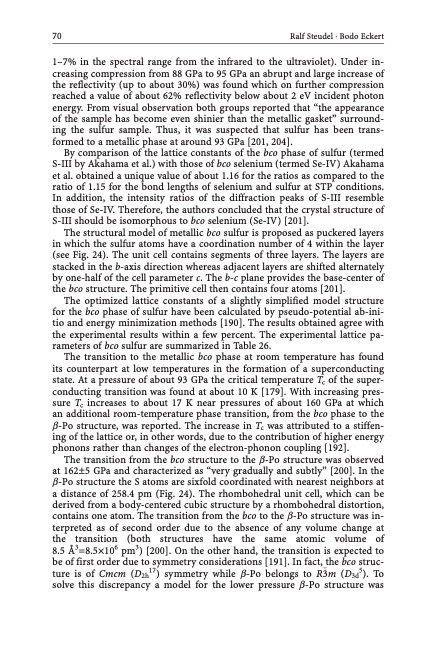
PDF Publication Title:
Text from PDF Page: 080
70 Ralf Steudel · Bodo Eckert 1–7% in the spectral range from the infrared to the ultraviolet). Under in- creasing compression from 88 GPa to 95 GPa an abrupt and large increase of the reflectivity (up to about 30%) was found which on further compression reached a value of about 62% reflectivity below about 2 eV incident photon energy. From visual observation both groups reported that “the appearance of the sample has become even shinier than the metallic gasket” surround- ing the sulfur sample. Thus, it was suspected that sulfur has been trans- formed to a metallic phase at around 93 GPa [201, 204]. By comparison of the lattice constants of the bco phase of sulfur (termed S-III by Akahama et al.) with those of bco selenium (termed Se-IV) Akahama et al. obtained a unique value of about 1.16 for the ratios as compared to the ratio of 1.15 for the bond lengths of selenium and sulfur at STP conditions. In addition, the intensity ratios of the diffraction peaks of S-III resemble those of Se-IV. Therefore, the authors concluded that the crystal structure of S-III should be isomorphous to bco selenium (Se-IV) [201]. The structural model of metallic bco sulfur is proposed as puckered layers in which the sulfur atoms have a coordination number of 4 within the layer (see Fig. 24). The unit cell contains segments of three layers. The layers are stacked in the b-axis direction whereas adjacent layers are shifted alternately by one-half of the cell parameter c. The b-c plane provides the base-center of the bco structure. The primitive cell then contains four atoms [201]. The optimized lattice constants of a slightly simplified model structure for the bco phase of sulfur have been calculated by pseudo-potential ab-ini- tio and energy minimization methods [190]. The results obtained agree with the experimental results within a few percent. The experimental lattice pa- rameters of bco sulfur are summarized in Table 26. The transition to the metallic bco phase at room temperature has found its counterpart at low temperatures in the formation of a superconducting state. At a pressure of about 93 GPa the critical temperature Tc of the super- conducting transition was found at about 10 K [179]. With increasing pres- sure Tc increases to about 17 K near pressures of about 160 GPa at which an additional room-temperature phase transition, from the bco phase to the b-Po structure, was reported. The increase in Tc was attributed to a stiffen- ing of the lattice or, in other words, due to the contribution of higher energy phonons rather than changes of the electron-phonon coupling [192]. The transition from the bco structure to the b-Po structure was observed at 162€5 GPa and characterized as “very gradually and subtly” [200]. In the b-Po structure the S atoms are sixfold coordinated with nearest neighbors at a distance of 258.4 pm (Fig. 24). The rhombohedral unit cell, which can be derived from a body-centered cubic structure by a rhombohedral distortion, contains one atom. The transition from the bco to the b-Po structure was in- terpreted as of second order due to the absence of any volume change at the transition (both structures have the same atomic volume of 8.5 3=8.5106 pm3) [200]. On the other hand, the transition is expected to be of first order due to symmetry considerations [191]. In fact, the bco struc- ture is of Cmcm (D2h17) symmetry while b-Po belongs to R3m (D3d5). To solve this discrepancy a model for the lower pressure b-Po structure wasPDF Image | Topics in Current Chemistry

PDF Search Title:
Topics in Current ChemistryOriginal File Name Searched:
Elemental-Sulfur-und-Sulfur-Rich-Compounds-I.pdfDIY PDF Search: Google It | Yahoo | Bing
Sulfur Deposition on Carbon Nanofibers using Supercritical CO2 Sulfur Deposition on Carbon Nanofibers using Supercritical CO2. Gamma sulfur also known as mother of pearl sulfur and nacreous sulfur... More Info
CO2 Organic Rankine Cycle Experimenter Platform The supercritical CO2 phase change system is both a heat pump and organic rankine cycle which can be used for those purposes and as a supercritical extractor for advanced subcritical and supercritical extraction technology. Uses include producing nanoparticles, precious metal CO2 extraction, lithium battery recycling, and other applications... More Info
| CONTACT TEL: 608-238-6001 Email: greg@infinityturbine.com | RSS | AMP |